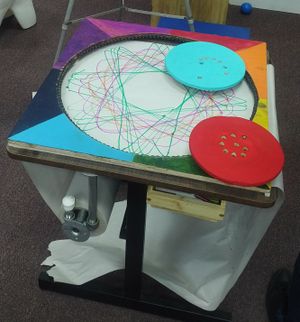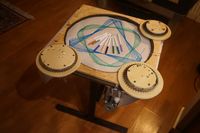Keannkline (talk | contribs) No edit summary |
Keannkline (talk | contribs) |
||
| Line 61: | Line 61: | ||
The Inspirograph is a larger upcycled tabletop version of a traditional children's toy spirograph design. The table stands at 28 inches high, which adheres to the Americans with Disabilities Act making it accessible for children of all backgrounds. The Inspirograph design implements a variety of upcycled materials. Upcycled materials are reinvented parts from previous use in order to prolong the life of these resources and reduce the amount of material from being thrown away. The Inspirograph uses re-purposed bicycle components to create the gears of the system while implementing a salvaged table for the system and salvaged plywood. | The Inspirograph is a larger upcycled tabletop version of a traditional children's toy spirograph design. The table stands at 28 inches high, which adheres to the Americans with Disabilities Act making it accessible for children of all backgrounds. The Inspirograph design implements a variety of upcycled materials. Upcycled materials are reinvented parts from previous use in order to prolong the life of these resources and reduce the amount of material from being thrown away. The Inspirograph uses re-purposed bicycle components to create the gears of the system while implementing a salvaged table for the system and salvaged plywood. | ||
== | ==Components== | ||
{{How to | {{How to | ||
|title= | |title= Components of the Inspirograph | ||
|header1= | |header1= | ||
|header2= | |header2= | ||
|pics= | |pics= | ||
|size= | |size= | ||
|File: | |File:Cogs.jpg |Caption |1 |The cogs of the Inspirograph are created from reused bicycle cogs. These bike cogs are sandwiched in between two circular cuts of plywood that act as protective coverings for the sharp parts of the gears. The plywood pieces and bike cog are spaced apart with rubber grommets to allow some flexibility in the movement of the inner cog on the track. This creates the appropriate spacing giving the cog an easy rotation along the bike chain. Along the top plywood piece holes are drilled in the shape of a Fibonacci spiral; this provides a place to put a writing implement. Using a Fibonacci spiral in pen placement allows the user to create different designs depending on which hole they use to draw with. | ||
|File:Hinged Gear Surface.jpg |Caption |2 |The surface of the Inspirograph is made from a sheet of plywood that has been attached to the table surface with two hinges. In the center of the plywood sheet a circular hole was cut to mount the bicycle chain and create the space for the user to draw the spirograph design. The hinges are utilized to allow the user to easily lift up the surface of the spirograph and replace the writing paper as seen in Figure 5-3. Simultaneously this provides a piece which holds the paper taught when drawing. | |||
|File:Hook & Paper Roll Mount.jpg |Caption |3 |A galvanized steel hook was used to create a durable and easily maintained paper roll holder. The hook holds a steel pipe which threads through a roll of paper. This allows the paper roll to be lifted out and replaced easily while reducing friction from rolling out the paper. The roll is held in place by two galvanized steel flanges screwed to either side of the metal pipe and once unscrewed, the paper roll can be easily replaced. | |||
|File: | |File:L-Bracket Supports.jpg |Caption |4 |Durability was a very important component in the Inspirograph, therefore to prevent possible breakage from over extension, L- Brackets were implemented. Illustrated in Figure 5-5, L-Brackets prevent the top surface of the spirograph from going beyond ninety degrees. This will prevent the hinges from experiencing too much downward force and breaking. It will also prevent an observer from being injured while the user is replacing the spirograph paper. | ||
|File:Marker Storage Box.jpg |Caption |5 |The concern that the Inspirograph markers would go missing resulted in the creation of a storage box. The box was placed on the underside of the tabletop for easy access and can hold up to 40 different colors. | |||
|File: | |||
|File: | |||
}} | }} | ||
Revision as of 06:44, 11 December 2017

Abstract
One paragraph summary of your project from background to discussion and next steps. There should be an image near the top.
The purpose of this project is to recreate an interactive children's toy from upcycled materials for the client of the Fall 2017 ERE 215 class. The client we collaborated with is the Redwood Discovery Museum, which is an educational, non-profit children’s museum located in Eureka, California. The toy our team, Team Black Box, decided to recreate was a traditional Spirograph. This project was one of 5 projects built for the Redwood Discovery Museum in an effort to contribute to the hands on learning that the Redwood Discovery Museum has to offer.
Background
Team Blackbox was started in Lonny Grafman's Fall 20117 ERE 215 design course at Humboldt State University. The client that Team BlackBox will collaborate with is Redwood Discovery Museum, an educational, non-profit children’s museum located in Eureka, California. The Redwood Discovery Museum educates young children in Humboldt County through fun exhibits intended for ages 3-8, incorporating the foundations of science, arts, and general health. Toy-maker and founder of the Redwood Discovery Museum, Ken Pinkerton, has hand-crafted many of the exhibits on display. Pinkerton has had a long-time passion for crafting toys with a philosophy of hands on education and to minimize further exposure to digital screens.
Problem statement
The primary objective of the project is to create an interactive exhibit for the Discovery Museum that provides an enjoyable experience for two types of children; those who are curious about learning something new and those with a desire to engage with science in a fun way. This objective comes with constraints from the client which will be upheld throughout the design of the project. Two constraints that will hold high value through every piece of the project design are 1) the requirement for a product which can withstand the destructive force which children embody and 2) a product which upholds the utmost safety and will not injure or harm the user in any way.
Criteria
Below is a table of criteria for the Inspirograph. Each criterion is weighted on a scale of one to ten to determine its degree of importance.
| Criteria | Weight | Constraints |
|---|---|---|
| Appeal | 5 | Multiple color options available for writing tool. |
| Operation & Maintenance | 8 | Must be less than $1.00/per day. |
| Ease of use | 8 | Must be easy to use by children ages 3-8. |
| Durability | 9 | Must last longer than one year. |
| Education | 9 | Must be understood by users ages 3-8. |
| Inspiration | 9 | Stoke factor. |
| Safety | 10 | Must be safe for children using ASTM Toy Safety Standards guidelines. |
| Cost | 7 | Expenses must not exceed a total of $500. |

Description of final project
The Inspirograph is a larger upcycled tabletop version of a traditional children's toy spirograph design. The table stands at 28 inches high, which adheres to the Americans with Disabilities Act making it accessible for children of all backgrounds. The Inspirograph design implements a variety of upcycled materials. Upcycled materials are reinvented parts from previous use in order to prolong the life of these resources and reduce the amount of material from being thrown away. The Inspirograph uses re-purposed bicycle components to create the gears of the system while implementing a salvaged table for the system and salvaged plywood.
Components
Costs
| Quantity | Material | Source | Cost ($) | Total ($) |
|---|---|---|---|---|
| 1 | Bearings | AMPT Skateshop | 10.88 | 10.88 |
| 1 | Screws, Drill Bits, felt pads, pens | Ace Hardware | 23.46 | 23.46 |
| 1 | Plywood | Pierson's Building Supply | 11.83 | 11.83 |
| 1 | Brackets, Hinges, Epoxy, Screws | Ace Hardware | 33.39 | 33.39 |
| 1 | Dowels & Hooks | Walmart | 4.17 | 4.17 |
| 1 | Galvenized Steel Piping | Ace Hardware | 66.46 | 66.46 |
| 1 | Corner Braces, Hinge Covers, PVC Caps | Ace Hardware | 8.20 | 8.20 |
| 1 | Epoxy, Wood Plugs | Ace Hardware | 18.41 | 18.41 |
| 1 | Sand Paper | Ace Hardware | 6.34 | 6.34 |
| 1 | Rubber Grommets | Ace Hardware | 24.98 | 24.98 |
| 1 | Felt Tip Markers | CVS | 7.37 | 7.37 |
| 1 | Hacksaw Blades | Ace Hardware | 6.49 | 6.49 |
| 1 | Salvaged Bike Parts | Arcata Scrap & Salvage | 10.85 | 10.85 |
| Total Cost | $241.60 | |||
Testing Results
The Redwood Discovery Museum now has an Inspirograph to add to their collection of exhibits. Not all children know how to express their artistic ability using a standard writing tool and paper. Yet, the Inspirograph allows children to make beautiful geometric designs with simple instruction.
Maintenance
The Inspirograph was designed and constructed to be durable. The life of the system is estimated to be 20 years. It was determined that the Inspirograph will undergo approximately 10 uses per business day. Given that markers and paper will be the primary components for upkeep, the estimated operation and maintenance cost will be roughly $200.00 per year. Figure 5-2 provides a breakdown of the operation and maintenance costs.
| Material | Annual Cost ($) |
|---|---|
| Marker | $28.08 |
| Paper | $156.60 |
| General Hardware | $10.00 |
Troubleshooting
For complex issues, please contact Ken Pinkerton.
| Problem | Suggestion |
|---|---|
| Paper orientation is wrong | Lift the top surface then use both hands to pull the paper across the bottom surface. Gently drop top surface back down onto paper to secure. |
| Inner cog is not connecting with outer cog | Gently press the cog against the outer cog to ensure the teeth of the inner cog are locking into the chain on the outer cog. |
Discussion and next steps
The results of building the design concluded that the Inspirograph will serve as a fun and inspirational exhibit for children to expand their creative learning. The system is safe, sturdy and able to withstand the ravages of time. It has been deemed simple to use and likely to expand a child’s cognitive learning by offering the ability to make artistic geometric patterns with ease.